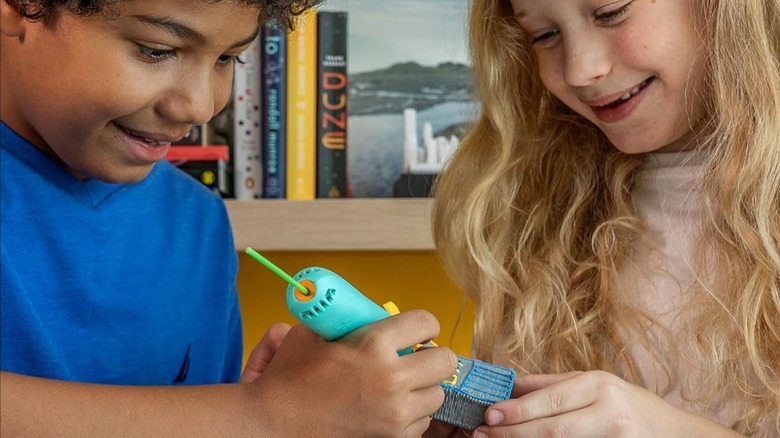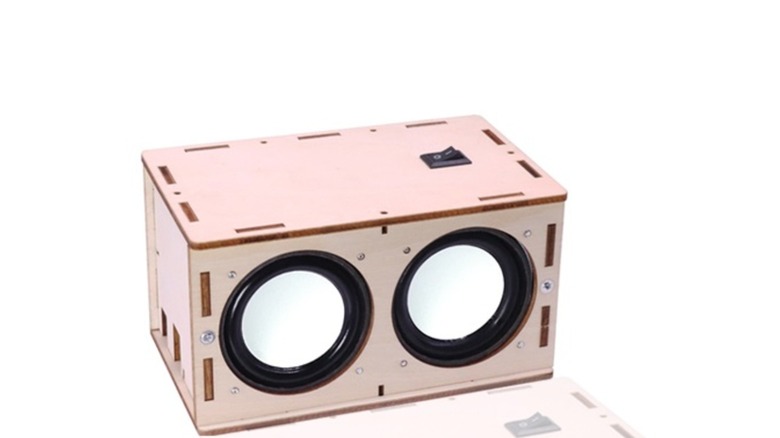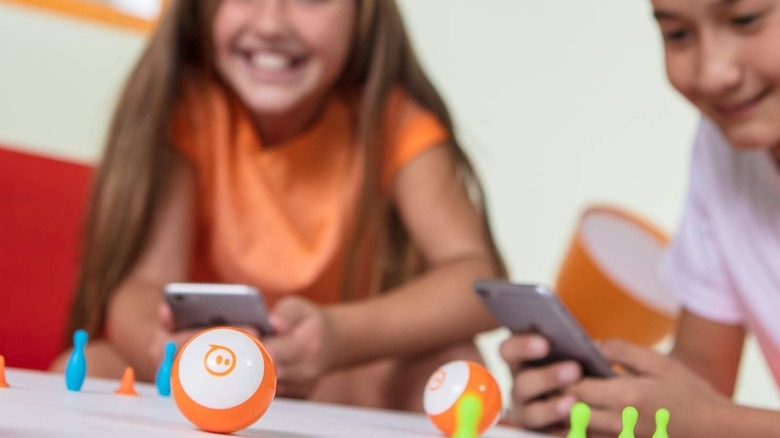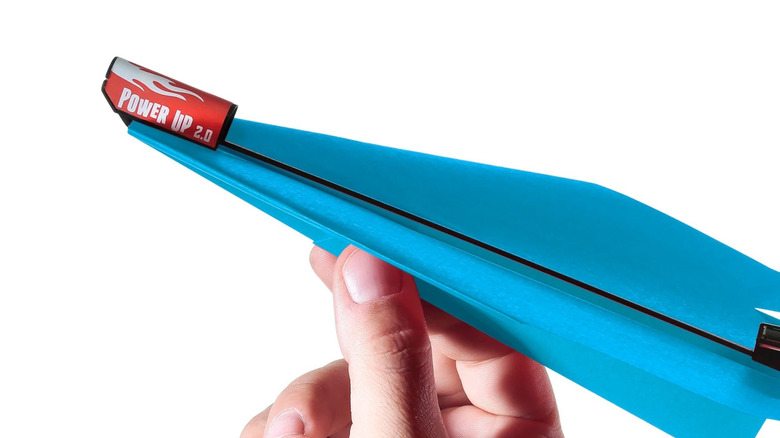10 Stocking Stuffer Ideas For Teens Obsessed With Tech
We may receive a commission on purchases made from links.
The holidays are fast approaching and the time for finding gifts and filling stockings is quickly dwindling. In generations past, you could get away with filling a stocking with holiday candies but today's teenagers want something a little more engaging.
What do you get for a generation of kids who grew up playing Minecraft and Roblox, who spend their time programming, 3D printing, and planning YouTube channels? If you've got a teen in your life who asks hundreds of questions you don't know the answers to and is always fiddling with some gadget or another, you might be struggling to decide what to get them for the holidays.
These stocking stuffers combine science, technology, and fun to bring some educational entertainment to the holiday season. If you're looking for ideas to jumpstart your gift planning these stocking stuffers are guaranteed to be a hit with the tech-obsessed teens in your life.
Ferrofluid toy
Ferrofluid is a colloidal solution with the properties of a liquid and a solid. The substance has its origin in the space race and now you can get some of your own in toy form. In the early 1960s NASA was hard at work trying to put boots on the Moon. One of the problems it needed to solve was how to make sure fuel ended up at the fuel pump even in microgravity.
NASA scientist Steve Papell developed a method of drawing fuel toward the fuel pump by applying a magnetic field. He did it by mixing tiny iron shavings into the rocket fuel, creating the first ferrofluid in the process. Today's ferrofluid toys are made of nanoscale iron particles mixed in water, oil, or some other organic solvent. The relationships of solid particles and the carrier liquid allow ferrofluid to behave as a liquid or a solid, depending on if a magnetic field is present.
Ferrofluid toys walk the line between entertainment and education by mixing physics and fun. The simplest versions are a bit of ferrofluid in a container and a magnet for you to pull it around with. More advanced ferrofluid toys can even connect to your phone via Bluetooth and bounce around to the beat of your favorite tunes.
3D doodle pen
These days 3D printers are all the rage but they require desk space, a computer, and patience. You also have to either rely on existing 3D print files or create your own. The advantage of a 3D drawing pen is that your creations are limited only by your imagination.
3D drawing pens work similarly to hot glue guns by feeding material through the pen and heating it at the tip. The filament comes out lightly melted and malleable, but it solidifies in seconds, allowing kids (or adults) to create 3D shapes. The 3Doodler Start+ is perfect for little kids and designed to be free of any burn risk. Even the melted filament is safe to touch. All you have to do is charge the pen, set the temperature depending on the type of filament you're using, push the filament into the back of the pen until you feel it click, choose the extrusion speed, and start making your own 3D creations.
The Start+ also comes with two packs of filament refills and a booklet filled with project suggestions. If you're looking for a more advanced 3D drawing experience, you can also opt for the 3Doodler Pro+, which is compatible with a wider range of filaments, including those made of wood, metal, flexible nylon, and more.
Thermal instant camera
In a world where everything has gone digital, there's growing nostalgia around the technology of yesteryear and instant cameras are making a comeback. While the revamped Polaroid company and competitors like Instax have recreated instant cameras that are actually worth your money today, kids can achieve similar results with a thermal printing camera too.
Instead of comparatively expensive instant film, these instant cameras use thermal paper to print images in black and white. Inside the camera, a roller moves the paper while a spring presses it against a heat-generating printhead. When exposed to heat, a chemical reaction takes place inside the paper, causing it to darken. When it rolls out the other end, you have a monochrome (black and white) image. The image quality is admittedly poorer when compared with film cameras, but they're perfect for young photographers looking to experiment.
The Yehtta Kids Camera features a full-color digital display and 32GB of storage courtesy of an SD card. In addition to printing pictures, you could use the SD card to print color pictures or upload them to a digital photo album. For printing, the camera comes with three rolls of thermal paper and refills can be purchased for about a dollar apiece. Each of those rolls can print about 100 photos, making them much more affordable than conventional instant film cameras. You can even get thermal sticker paper so your tech-obsessed teen can make their own instant stickers.
Bluetooth speaker kit
The best Bluetooth speakers make great stocking stuffers and these kits go the extra mile by coming totally disassembled. "Some assembly required" is usually not a selling point but your tech-obsessed teens will love putting these kits together. They'll get the fun of exploring basic circuitry and engineering and end up with a functional speaker when they're finished.
The Cyoest DIY Bluetooth Speaker Box Kit features a laser-cut wood frame housing two 52mm speakers. It's an entry level project for kids interested in learning the basics of circuitry without any soldering. Plug all of the components into the appropriate ports, place a few screws, snap the frame together, and you're finished. The whole thing connects to a battery pack mounted at the back and is powered by 4 AA batteries (not included).
If you're looking for a slightly more challenging build with a cooler outcome, check out the DIY Bluetooth-Compatible Speaker Kit from Mioyoow. It features a clear housing that allows you to see the circuitry when it's finished. An array of LED lights add a visual element and a remote lets you control its various features at a distance. This kit does require some soldering and may be more appropriate for more experienced kids.
Solar powered robot
Taking inspiration from plants, solar cells collect energy from the sun and convert it into electricity you can use to power a spaceship, your house, or a tiny robot. The international space station (ISS) is the largest spacecraft ever built by human hands and it's powered entirely by energy from the sun. The station is powered by more than 262,000 solar cells spread out over 27,000 square feet. They generate between 84 and 120 kilowatts of electricity to supply the station with all the energy it needs. A single solar cell generates way less energy, but it's enough to power this tiny shapeshifting robot.
The Raesooot Solar Robot Kit is 12 robots in one, capable of being built into a wide range of configurations including the Roly-Poly-Bot, the Turtle-Bot, the Crab-Bot, the aquatic Surf-Bot, and more. All you have to do is remove the pieces from the supporting plastic frame and assemble them according to the included instructions. Regardless of the form you choose, each robot can be powered with batteries (not included) or by solar power. The tech-obsessed teens in your life will enjoy assembling these robots and exploring the physical limitations of different robotic designs.
Cleaning goo
We're all familiar with the way dust, crumbs, and other debris find their way into the nooks and crannies in your computer's keyboard. Anyone who uses technology regularly knows that you end up with pocket lint, dust bunnies, and grime in hard to reach places, and that's especially true when the user is a teenager. We all need a good way to keep our gadgets clean.
There are many ways to clean your gadgets, but air dusters and custom brushes aren't nearly as fun as smashing cleaning slime into your devices can be. Slimes like the ColorCoral universal cleaning gel work by squeezing into tight spaces and grabbing hold of anything they find.
Kids love playing with slime but they always end up dirty, covered in crumbs and cat hair. In this case, that's a feature, not a bug. This cleaning gel comes in blue or yellow and has a faint lemony smell. Each order contains two jars of slime, each of which can be used for dozens of jobs. Just wash your hands, tear off a piece of slime, roll it into a ball, and smash it into your keyboard, dirty ports, and any other hard to reach places.
Blue light glasses
Doctors recommend fewer than two hours of screen time per day for teens and adults, but the reality is that most of us are exposed to computers, phones, TVs, and other screens a lot more than that. If you can't reduce the screen time, you can potentially reduce some of the negative effects with a pair of blue light glasses. These aren't the coolest tech gift on your kid's holiday list, but they can be used while looking at screens or as eye protection while wiring gadgets in the bedroom laboratory.
The CDC says that kids aged 11-18 average between 7.5 and nine hours of screen time each day, and excessive use is associated with eye strain and insomnia. The data on whether blue light glasses are beneficial is still pretty inconclusive. Claims that they reduce eye strain probably aren't supported. Eye strain mostly comes from a decrease in blinking when using screens, which can't be impacted by wearing glasses. Blue light glasses may help your teen to sleep better by reducing blue light stimulation at night.
Of course, the best solution is to reduce screen time, especially in the hours leading up to bed time. That said, if you've got a kid who stares at screens a lot, it won't hurt to add an extra layer of protection. And if your teen doesn't usually wear glasses, they might serve as a physical reminder to take breaks every now and again.
Sphero Mini
The Sphero Mini is a simple, spherical robot about the size of a ping pong ball. It has a gyroscope, accelerometer, and LED lights which you can use to drive your robot. It comes in a variety of colors and you can swap out the shell to change the color or make it look like a soccer ball or golf ball.
Using the free Sphero Edu app, you can drive your Mini in several interesting ways. The most intuitive is joystick driving, in which you drag a blob on the screen in the direction you want the Mini to go. The farther you drag it, the faster the Mini moves. You can also use tilt driving to control your robot by tilting your phone or try face driving to control your Mini with facial expressions and head movements.
Instead of using the app to control your Mini, you can also use the Mini as a physical controller to play in-app games. For your tech-obsessed teens, the app also has activities which help them to learn programming and control their Mini with code. If you're looking for a more advanced experience, Sphero also has enhanced models to choose from with a wider array of functions, including the see-through Sphero SPRK Edition.
Lego Technic
Lego started introducing more complex sets with moving parts in the late '70s and the company established the Technic label in 1982. Each set came with instructions for making a variety of models, each of which had at least some moving parts like wheels and gears. Some sets even include electric motors and other powered pieces.
Today, the line includes kits in all shapes and sizes, some of which are elaborate and expensive while others are simpler, smaller, and affordable, perfect for a stocking stuffer. You'll find replicas of sports cars and spaceships alongside models of the solar system and more. You'll also find beginner level Technic sets like monster trucks and farm tractors.
Lego brick sets are familiar to most kids, making the Technic line a perfect entry point for a budding engineer. The addition of motors, pneumatic systems, and other moving parts are the perfect gateway toward engineering, programming, and a lifelong fascination with science and technology.
Powerup paper airplane
If you've ever wanted to take your paper airplanes to the next level, the powered paper airplane kits from Powerup are exactly what you've been looking for. The Powerup 2.0 is made of a slim rod which runs from the plane's nose to its tail, with a propeller at the back. It can attach to any standard-sized paper airplane and provide powered flight for about 30 seconds per charge. Teens can experiment with different plane shapes to learn about the physics of aviation.
The kit is made of carbon fiber so it can take a punch when it hits the ground. The more advanced Powerup 4.0 allows for controlled flight with a bluetooth connection and smartphone app. A built-in onboard computer improves flight stability and increased battery life gives you 10 minutes of flight time on a 30 minute charge. The Bluetooth range is about 230 feet, giving you plenty of space to fly around and a larger carrying capacity allows for heavier planes (up to 20 grams) made of foam or balsa wood. You can even go for a miniature flying paper dragon to add a little fantasy to your teen's holiday season.










